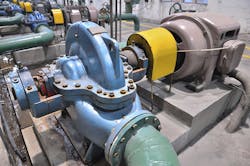The Hydraulic Institute recently published a new tool to help end-users understand the application-specific design features that affect rotodynamic pump efficiency.
"This document is essential for pump end-users, specifiers and purchasers," said HI Technical Director, Pete Gaydon, in a press release. "It educates the reader on tradeoffs between design and efficiency and allows the pump purchaser to understand what efficiency is generally attainable for their application. In particular, specifying engineers can compare quoted efficiencies against the generally attainable efficiency".
READ ALSO: HI Seeks Input on Efficiency-Focused Circulator Pumps Standard
The Hydraulic Institute Guideline for Rotodynamic Pump Efficiency Prediction HI 20.3–2015 allows end-users to calculate the normally attainable efficiency and uncertainty band for the following pump types:
- Slurry, end suction
- Solids-handling, end suction
- Submersible sewage, end suction
- Horizontal multistage & axially split diffuser type
- ASME B73 chemical process
- API end suction
- Large, end suction
- Double suction, API and other
- Vertical turbine, mixed and axial flow, single and multistage diffuser type
The efficiencies shown in this guideline are those generally obtained using common manufacturing practices and are based on a survey of pump manufacturers. Only the best efficiency point (BEP) values are addressed in this guideline.
The guideline is available in the HI eStore for $50. HI members receive a 25 percent discount.


